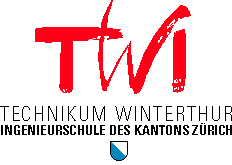
 |
Abteilung Elekrotechnik Praktische Diplomarbeiten |
|
| Mechatronics |
 |
|
||||||
| student: | Bearth Roy | ||||||
| Knecht Marco | |||||||
| Nicoli Severo | |||||||
| dozent: | Brom Bruno-Charles Prof., Dipl. El.-Ing. NDS ETH | ||||||
| abstract: | |||||||
|
The diploma work "walking robot" was carried out from 3 September to 26 October with the following aims: To examine the courses of motion of a two-legged robot and to use the results and formulas for the software.To write the software for the walking movements (at least walking straight forwards) of the robot.For this type of motion we want to use the existing hardware (Handyboard and expansion board). We want to manufacture the current supply (and distribution), possible addition electronics, CAN - controllers with integrated motion controller and power modules.Put the robot when walking straight forwards into operation. Look for solutions and possibly implement there for other movements. Already at the beginning of the work we realised that the construction of the robot would have to be modified, before we could begin controlling the drives. Completion of the work: We dedicated a large part of our time to the research into possible solutions for these problems. We had looked for reasonable solutions, so that the targets of our diploma work still remained attainable: Also when the robot was already at the Aerotech for the first modifications, we had to examine further mechanical problems, and as soon as we had found a possible solution, the mechanic was informed immediately.During this 5 weeks, while the robot was being mechanically improved at the workshop, we continued to work with the hardware and the software. After detailed structuring of the procedures, we wrote the code for the main program, motion controller- and CAN- controllers- procedures in interactive C. Communication between the main controllers and the motion controller that controls 6 DC - driver, takes place via CAN - bus. Six power modules were constructed and tested.
Results achieved:The written main program makes walking on a pre-defined course possible. It can be extended however. | |||||||
| student: | Fedele Andreas | ||||||
| Martin Christian | |||||||
| dozent: | Brom Bruno-Charles Prof., Dipl. El.-Ing. NDS ETH | ||||||
| Frommer Heinrich Prof., Dr. sc. techn., Diplom-Physiker | |||||||
| abstract: | |||||||
|
This diploma paper is based on last year's diploma paper "Autonomes Fahrzeug PACIFICAR" which deals with the parking procedure of a car model. Our main task was to improve the whole parking procedure. For the simulation of the mechanical steps we had the powerful software programm ADAMS at our disposal. The MATLAB software was used for the calculation, controlling and regulation of the parking procedure. It is capable of exchanging data with the software used for the simulation process.Unlike last year's diploma project, we set our focused on the simulation of the parking process. We started out by assuming an ideal parking process which we defined as a simple one-step move. The definition and implementation was another important point in the concept of controlling and regulating with the fuzzy control notation. Furthermore, the theoretical analysis of the correction process during the parking procedure and the correction of the end position was crucial.After extensive introductory training on the mentioned software tools, we were able to create a program that allowed us to run our virtual vehicle on a defined track. MATLAB provided us with the necessary tools for this task. One option to work on the fuzzy-regulator's block-symbols, which are used in SIMULINK, is to utilize a convenient graphic platform. The switch between the individual fuzzy-regulators, all of which are optimized to their controlling range, was implemented by State-Event technology. MATLAB also offers a fitting tool for the State-Event technology, allowing us to illustrate in a detailed manner the state transitions and the events. During the simulation process we were able to constantly monitor which regulator was active at any given time. This ability was of great help with regard to optimizing the regulator shift. | |||||||
| student: | Haussmann Oliver | ||||||
| Schait Christian | |||||||
| dozent: | Brom Bruno-Charles Prof., Dipl. El.-Ing. NDS ETH | ||||||
| Zeman Jan Prof., Dr. sc. techn. Dipl. El.-Ing. ETH | |||||||
| abstract: | |||||||
|
The aim at our diplom project was to develop a motor control for a switched reluctance motor SRM, by using DSP TMS320C240 from Texas Instruments, which is optimized for motor controls. An evaluation board contains the processor, which is connected to the computer. The programming of the DSP took place in C. We developed a display board in order to both visualize and influence data. The display board contains two displays, five potentiometers, three switches as well as two adjustable I/O - ports. These ports allow both the entry of data and its visualisation on LEDs The display board has to be pinned on the evaluation board, and is thus connected to all connectors. After seven weeks of intensive work we had a display board and the software to control the board. Although the motor control software needs to be improved within another project, we can see that it is possible to operate an sr - motor with that DSP, since enough velocity reserve remains to implement more features. All the three states starting, auto commutation and commutation with variable angles work well. The control of the current and speed still needs some upgrading. This DSP is well suited to the requirements of our work; at the maximum speed of 25'000 rpm its utilization is about 25%. Furthermore no external hardware is necessary to realize all functions.
The main focus of our work was in the development of software. Interrupts influence the running cycle in our program, and this factor made program design more difficult. | |||||||